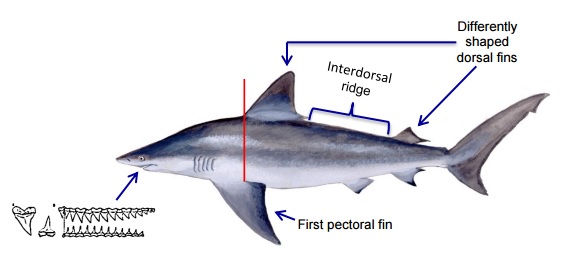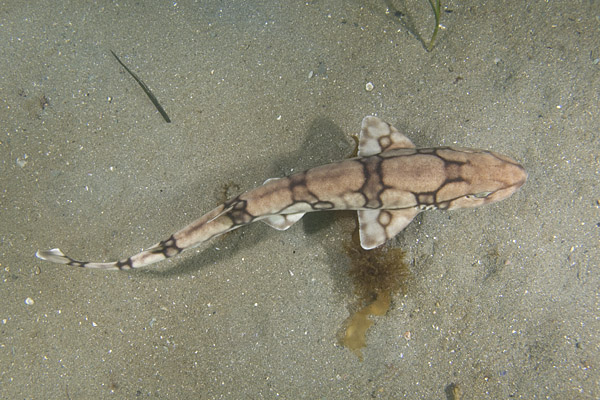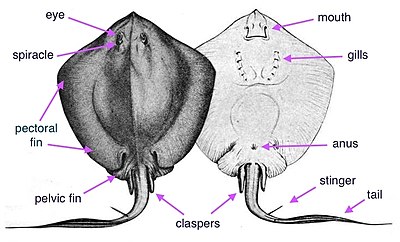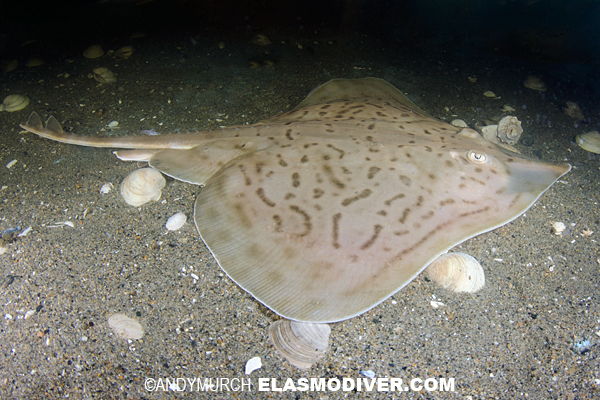Shark & Ray Anatomy and Biology
SHARKS When did the first sharks come about? About 450 million years ago during the Paleozoic Era, the Cladoselache existed. This is millions of years before the first dinosaur.
When did the first sharks come about? About 450 million years ago during the Paleozoic Era, the Cladoselache existed. This is millions of years before the first dinosaur.
How many species of shark are there? There are over 368 different species of sharks, skates, and rays.
Are sharks part of the Vertebrate family? Yes, they do have a backbone made of cartilage.
How many types of fish are there? First, there are two types of fish. Bony fish (Osteichthyes) which account for 95% of all fish. The other type is the cartilaginous (Chondrichthyes) which make up the other 5%.
What type of fish is a shark? They are members of the cartilaginous family, meaning that their skeletons are made of cartilage, as is found in your nose and ears.
Are there other types of cartilaginous fish? Yes, there are two sub sets. The first is the Elasmobranchii(sharks, skates and rays) which have multi gill slits, and then there are the Holocephali (Chimeras).
What benefit is there to being cartilaginous? The skeleton assists in buoyancy and flexibility. However, because they are not bone, they decay rapidly, leaving few remains or fossils.
How well do sharks swim? Efficiently, to say the least. Most are very well adapted for swimming. The tail (caudal fin) provides most of the power. Tails vary in size from 20% of the body length (angel sharks) to over 100% (thresher sharks). The dorsal fin is rigid and used to stabilize roll.
The pectoral fins are used to plane, lift, and maneuver. The dermal denticles on the skin help prevent drag, by creating laminar flow over the body.
Do they have any swimming shortcomings? Yes. For one thing, they cannot swim backwards.
How do they maintain buoyancy? In several ways. One key factor is with their liver, which can be as much as 25% of their body weight. The liver produces oil, which is lighter than water, thus helping them float. Another way, often used by our sand tiger sharks, is to gulp air. Fin formation also helps.
How fast do sharks swim? It depends on the species and activity. The mako shark has been clocked at 60+ miles per hour while feeding. On average, our sharks cruise at about 3-4 miles per hour.
How big and small do sharks grow? The largest shark today is the whale shark, which can reach a length of 50+ feet. The smallest one is the dwarf dogfish, who when mature measures in at a whopping 7 inches long from nose to tail.
How long do they live? In the ocean, we don’t know. By tagging sharks we have come to estimate that the average life span is approximately 25 years. However, a big exception is the spiny dogfish, which has been known to live over 100 years.
Is it easy to tell their age? No, it is very hard to determine age without having to dissect one. Shark species grow differently from one to the other and since they have no bones or scales, growth patterns do not exist.
What is their skin like? In one word, unique. It is very tough and very abrasive. It is made up of dermal denticles, which is what their teeth are also made up of. The skin is so rough, that one can be hurt just by being bumped and rubbed by a passing shark. Dried shark skin was once used as a type of sand paper.
How many teeth do sharks have? That number will vary by species, with some having no teeth at all to some that have hundreds of teeth growing at once. The teeth are embedded in their gums and not in their jaw, as found in other fish or man. They are constantly replacing the oldest row of teeth with a new row. Some sharks may shed up to 30,000 teeth in a lifetime. Teeth are normally replaced, on average, every six months, but some sharks replace them every 8-10 days. Teeth can also help in determining the size of a shark, since the size of the tooth is normally directly associated with the overall size of the shark.
How often do they eat? In the ocean, it varies greatly from days to weeks. Ours are currently (2019) fed 3x/week. Sharks are capable of varying the rate at which their food is absorbed by use of their unique spiral valve.
Where are sharks found? Sharks are found in all the oceans of the World, in the shallows of Long Island Sound to the depths of the ocean.
Are sharks found only in Salt Water? You would like to read yes, but there are several species that are known to live in fresh water, such as the bull shark. One such animal was found in the Mississippi River near St. Louis.
What are baby sharks called? They are called pups.
How many are normally born at one time? This varies by species, so it could be only one, but could be up to 100.
How do they reproduce? Many sharks reach sexual maturity near the age of 15 and may reproduce only every other year. There are three types of reproduction in sharks.
• One is live bearing (placental viviparity) where the embryo is attached to the mother by an umbilical cord and receives nourishment and provides for the elimination of waste. The female may carry from 2 to 135 pups. The blue shark has the record of 135 known embryos.
• Laying of external egg cases (oviparity). These develop on their own, dependent on the yolk reserves for nutrition. The eggs are usually large (1-2 inches). The whale shark eggs can be quite large and the pup, when born, be approximately 14 inches long. Since the eggs are laid externally, there is no protection offered from outside predators.
• Laying of internal egg cases (ovoviparity). The eggs actually develop within the uterus until development is complete but are not attached to the mother in any way. This is the most common reproductive process found in sharks. It affords shelter and protection during the development process. Some species of shark will have the pups hatch within the uterus. These pups require nutrition and will actually consume the newer eggs the mother continues to lay throughout gestation. This process is Oophagy. (Great whites, makos, threshers, sand tigers are just a few of the know oophagous sharks.
The record for the longest gestation period of any vertebrate is 22-24 months, held by the spiny dogfish. The elephant is 22 months maximum.
Shark attacks? Of the over 368 species of sharks, very few have ever been recorded as attacking man. The most dangerous species are: Great whites, tiger sharks (not sand tigers), bull sharks, white tip reef sharks, hammerheads, makos, lemon sharks, and black tip reef sharks.
How many people die from shark attacks? On average, there are fewer than 10 fatal attacks a year, worldwide. Studies show that a great number of those were provoked by humans. Compare this to the 50 deaths each year attributable to snake bites, just in Brazil alone, makes the number of shark attacks seem very small. In fact, more people are killed each year by domestic pigs than sharks.
Are there any benefits to humans? Besides being a food source, sharks have assisted man in many ways, but it is in the area of medical research that they have proven extremely beneficial.
• Extracts of shark cartilage are used as temporary skin for burn victims. Shark eye corneas have been transplanted into humans.
• Cancer research.
Sand tiger shark (Carcharias taurus) a.k.a. - grey nurse shark
Habitat: Warm and temperate waters of the ocean, sandy shorelines, shallow bays and submerged reefs down to about 600 feet.
Range: East coasts of North and South America. Also found in the Mediterranean, Japan, Australia and South Africa
Size: Range in length from 6.5 - 10.5 feet. Can weigh between 200 - 350 pounds.
Behavior: Docile, slow-moving, non-aggressive.
Appearance: Stout, bulky body with a sharp, pointy snout. Three rows of sharp-pointed teeth protrude from the mouth. They have two large dorsal fins and an elongated caudal fin.
Color: Grey with reddish-brown spots on back with a pale underside.
Diet: Bony fish, crustaceans, squid, skate
Reproduction: Ovoviparity (Internal egg cases) The eggs actually develop within the uterus until development is complete but are not attached to the mother in any way. Pups hatch within the uterus. These pups require nutrition and will actually consume the newer eggs the mother continues to lay throughout gestation. This process is Oophagy. The sand tiger is only known shark who’s pups are embryophagous or intrauterine cannibals. They will actually consume the smaller pups, just hatched, once all the smaller pups are gone, they will eat all the available eggs the mother produces. Because of this cannibalistic process, the sand tiger will only bear one pup per uterus. Males reach marturity at 5 - 7 years of age, females at 7 - 10 years.
Fun Fact: The sand tiger shark is the only known shark that gulps air and stores it in the stomach. This allows the shark to maintain neutral bouyancy.
Sandbar shark (Carcharhinus plumbeus ) also commonly known as brown shark.
Habitat: Relatively shallow coastal waters of harbors, bays and estuaries with sandy and muddy bottoms. Sandbar sharks generally prefer to stay in the water column, not near the surface. They avoid freshwater.
Range: Found in tropical to temperate waters worldwide, including the East coast of the Americas from Massachusetts to Brazil. It is one of the four species of shark known from the Long Island Sound (the others being the sand tiger shark and two small species of dogfish)
Size: Adults can reach up to 6 feet in length.
Longevity: 24-28 years. Have been documented to live over 30 years on occasion.
Behavior: Known to feed all day, but are most active at night. Carcharhinid sharks have a very high metabolism and energy demand, and one of the types of sharks that need to keep swimming continuously to provide enough oxygen. If they stop swimming, they will go into oxygen debt, and their musculature accumulates lactic acid in a condition called acidosis. This can be fatal to the shark if not immediately corrected.
Appearance: Characterized by their large triangular dorsal fin, uniform gray coloration and long pectoral fins that resemble wings. Rounded snout with triangular saw-like teeth.
Color: Gray body with white underside.
Diet: They prey primarily on small fish, crustaceans and mollusks. They are a benthic feeder, and mostly find prey near the bottom. Stingrays and flatfish (flounder and soles) are a favorite food for them, along with crabs and squid.
Reproduction: Ovoviviparity (Internal egg cases) The eggs hatch inside the female and parturition occurs live- with 6-13 live pups being delivered per female. Mating is known to be especially violent in this species, often leaving the females scarred from bite wounds sustained during breeding. Wetland habitat and estuaries from Delaware Bay to North Carolina are important spawning habitat for this species in North America. Gestation is most commonly 8-12 months, but can vary by geographical location.
Conservation Status: IUCN lists them as 'Endangered'. They are not listed on the US Endangered Species Act, but they are protected in many states.
Fun Fact: The sandbar shark is closely related to the bull shark, blacktip shark and lemon shark.
Fun Fact: The sandbar shark is a member of the family Carcharinidae, the requiem sharks. Carcharhinidae comes from the Greek word 'karcharos', meaning sharp, and 'rhinos', meaning nose. Members of the Carcharhinidae have sharp, pointed snouts compared to other shark species. The specific name plumbeus is derived from the Latin word 'plumbos', meaning lead, describing the grey color of the species.
COMPARISON
Sand tiger Shark Sandbar Shark
Commonly range in lengths from 4 to 10 feet. Commonly range in lengths from 3 to 7 feet.
Coloration of upper side is light brown or light greenish, with the underside a grayish white. Coloration of upper side is bluish to brownish gray with the underside a lighter shade of the same color to white. Many have darker reddish or brown spots scattered on the body.
First dorsal fin is far back on body, behind the first pectoral fin. First dorsal fin sits high, and aligns with rear attachment point of first pectoral fin.
First and second dorsal and anal fins nearly equal in size. Differently shaped dorsal fins. Defined interdorsal ridge.
Flattened snout. Teeth are large and needlelike, protruding from mouth. Rounded snout. Upper teeth are broadly triangular and serrated. Lower teeth narrower, more finely serrated.
.jpg?seed=77151&url=assets/img/sandtiger%20(2).jpg)

Brownbanded bamboo shark (Chiloscyllium punctatum)
Touch Pool Species
Habitat: Coral reefs and tide pools
Range: Western Pacific Ocean
Size: Slightly over 1 meter in length
Color: Adults brownish with faint bands. Juveniles have dark bands.
Diet: Carnivorous feeding on scallops, squid, shrimp, and small fish
Reproduction: Oviparous (egg-laying)
Fun Fact: They have barbels under their chin for sensing and finding food hidden in the substrate.
Fun Fact: These sharks can survive out of water for up to 12 hours.
Whitespotted bamboo shark (Chiloscyllium plagiosum)
Touch Pool Species
Habitat: Coral reefs
Range: Pacific Ocean - Japan to India
Size: Up to 1 meter in length
Color: Brown body. Dark bands with white and dark spots.
Diet: Carnivorous eating small fish and invertebrates
Reproduction: Oviparous (egg-laying)
Fun Fact: They tend to be nocturnal.
Chain catshark (Scyliorhinus retifer)
Habitat: Bottom-dwelling.
Range: Northwest Atlantic Ocean (New England to the Caribbean), Gulf of Mexico
Size: Up to 2 feet in length.
Color: Reticulated pattern.
Diet: Carnivourus eating small fish, squid, crustaceans
Reproduction: Oviparous (egg-laying)
Fun Fact: These are a nocturnal species.
Fun Fact: These sharks possess bioflourescent properties.
Coral Catshark (Atelomycterus marmoratus)
Touch Pool Species
The coral catshark is vibrantly colored. These sharks, which reach more than 2 feet long, live among coral reefs, eating invertebrates and small fish. Their leopard-like pattern provides camouflage as they swim through their reef habitat.
This species is most widely distributed member of its genus, the coral catshark can be found from Pakistan and India to Southeast Asia and Taiwan. Common and bottom-dwelling in nature, the coral catshark inhabits inshore coral reefs at depths not exceeding 15 meters.
Due to habitat destruction and overfishing, the coral catshark is listed as a vulnerable species on the IUCN Red List of threatened species.
STINGRAYS

What is a Stingray? One of four members of the cartilaginous fish (Chondrichthyes) which also includes the sharks, skates and chimaeras. Anatomically they lack a swim bladder and must keep moving or they sink to the bottom. The stingray group includes 200+ species. They differ from skates because of the presence of one or two spear-tipped venomous spines located close behind the dorsal fin. They differ from sharks by having their gill slits and mouth on the bottom.
How do they breathe on the bottom? Many species will settle on the bottom and shake to cover themselves with a thin layer of sediment. Spiracles on their back allow them to take in water which they expel out the gills on the bottom.
What variety is there within the ray species? The largest is the manta ray which can be 20’ across and weigh 3,000 lbs. The most shark-like is the sawfish ray at 20’ weighing 800 lbs with its long pointed snout covered with pairs of teeth or spines.
Why does their skin feel slimy? Most members of the shark family are covered in denticles. However, rays have a smooth surface covered with a mucous. Scientist think the mucous fills the valleys on the skin surface making it extra smooth. We think this allows for less hydrodynamic drag, much like the surface of a submarine is smooth.
Shark or Ray sighting? Reportedly over 50% of shark sightings at beaches are a case of mistaken identity. Rays sometimes hold the tip of their wing or fin above the water as they swim. It looks amazingly like a shark’s dorsal fin.
Are they dangerous? Australian experts reported stingrays are thought to have been responsible for 17-30 deaths per decade. Steve Irwin was the 3rd known in Australian waters. About 50% of stingers will contain venom. Our aquarists trim the stingers periodically, they are not removed. At Stingray City in the Grand Caymans – all have their stingers. Even when trimmed please note they grow back like fingernails. In one report they injure 1,500 people annually in the United States with most cases resulting from stepping on the docile creatures.
Is the stinger or spine made out of bone? No, it’s a hard bonelike substance called vasodentine. It resembles a steak knife with serrations on both sides.What should be done for first aid? In 50% of cases the injury is limited to a puncture wound, sometimes a deep one. The stinger will break off in the wound in many cases. DO NOT remove this yourself, go to a doctor where this can be removed with the least amount of additional injury. The serrations, much like a fish hook or arrow, will do much more damage during removal than the initial impalement.
Immersion in hot water (hot as you can stand it ~115 degrees) for 30 to 90 minutes can disable the proteins in the venom from causing further damage. Reportedly this has the effect on the protein like boiling an egg until it is hard boiled.
Where is the stinger? It varies from species to species. On cow nosed rays the stingers are located where the tail is attached to the body.
A full grown spine will be 4-7 inches in length and ½” to 1” in width. The venom producing tissue is located along two ventral grooves that run the length of the spine.
Serrations along the edge and razor like sharpness make this a formidable defensive weapon. Predators like sharks and sea turtles find this a deterrent but not a complete one. Divers find they can easily pierce a wet suit or a swim fin. The sturdy booty and swim fin combination is no match for an annoyed ray.
Cownose Rays (Rhinoptera bonasus)
What is their range? Many cow-nosed rays stay year round in waters from Brazil to the Gulf of Mexico. Sometime around May many start to arrive in the mid Atlantic region and depart ~October. Some will work their way up the eastern seaboard to as far north as Long Island Sound. Northbound they travel in small to medium size groups. Southbound they can hookup and form large herds for the return migration to the warmer waters. As a summer vacation activity, this is quite a swim for a visit to the New England clam beds. In one study in 2005 using satellite transmitters, they migrated at 12-15 miles per day. When traveling they average about 4-5 mph
Their major predator, the shark, has seen its numbers diminish by 90% since 1945. The result has been a strong growth in the number of rays. One consequence has been a substantial destruction of the habitat of shellfish living in eel grass. The feeding practice of packs of rays using their large fins to dislodge the top 6-9” of sea floor has not been helpful to the scallop population. The reduction is seen by consumers as a significant rise in the price of scallops in the market. In an ironic twist of fate, some restaurants will substitute medallions stamped out of ray wing for the pricier scallops. Taste, texture and smell are similar. Savvy diners will always know the difference. The grain on a scallop runs up and down. You’ll notice your fork goes through it easily. The ray fin medallions will have the grain running sideways…
How do they reproduce? In the springtime the males will be attracted to the females which have gone into estrus (heat). Fertilization is internal. The males have twin claspers.
Cow nosed rays give birth to live young which hatch from an egg in the uterus of the mother. A process called ovoviviparous. After the yolk is absorbed, the embryos are nourished by secretions from the villi on the inner wall of the female uterus. The unborn young lie in the uteri in pairs, rolled together head to tail. As many as six have been found in one female. Embryos in the late stages of development have the tail spine safely embedded in the skin and resemble their parents except for somewhat longer tails.
Hunting in packs (10, 20 to 50 animals) they can be quite destructive to the eel grass beds that are home to both mollusks and a host of smaller fish. The aftermath can look like a minefield. Oystermen often construct fences and plant poles to discourage the rays. The water will look like its boiling during feeding and sometimes gives the appearance of a whirlpool. While interesting to watch, if you’re swimming, give them their space.
The largest of the rays, the filter-feeding Mantas feed on plankton and small fish.
The position of the mouth on most rays allows them to exert quite a bit of vacuum pressure.
How long do they live? We do not know. Estimates for cow nosed rays range from 16y -18y in the Gulf of Mexico to 13 years old on the Western Atlantic. Much is unknown about their way of life.
Can they smell? Yes – When you are related to sharks who can smell one part in a billion, you have quite the sensitive nose. In addition, the rostral lobes on the cow-nosed rays sense electrical vibrations, sound and touch. They can detect the electrical impulses from a clam buried deep in the sand.
Clearnose Skate (Raja eglanteria)
Habitat: Skates are demersal, living on or near the bottom of the sea. Clearnose skates prefer shallow, partially saline water, but can be found in deeper waters.
Range: East coast of the United States from Massachusetts down to and around the Florida peninsula. Also found in the eastern and northern portions of the Gulf of Mexico.
Size: Up to 31 inches in length and 20 inches width feet. The tail accounts for approximately half the length.
Behavior: Clearnose skates use their modified pelvic fins to walk, or "punt", along the benthic substrate. Also swim through the undulation of their pelvic fins.
Appearance: Roughly disc-shaped body with pointed snout and pectoral fins. Translucent patches on each side of central ridge of the snout. Two relatively large, equal-sized dorsal fins near the tip of the tail.
Color: Brown to grey color on top, white underneath.
Diet: Crustaceans, mollusks, small fish.
Reproduction: Oviparous (egg laying). Lay fertilized eggs, commonly called "Mermaid's purses". Up to 30 pairs of eggs may be deposited by a female. Approximately 12 week incubation period. Age of maturity ranges from 2 - 6 years, with females taking longer to mature.